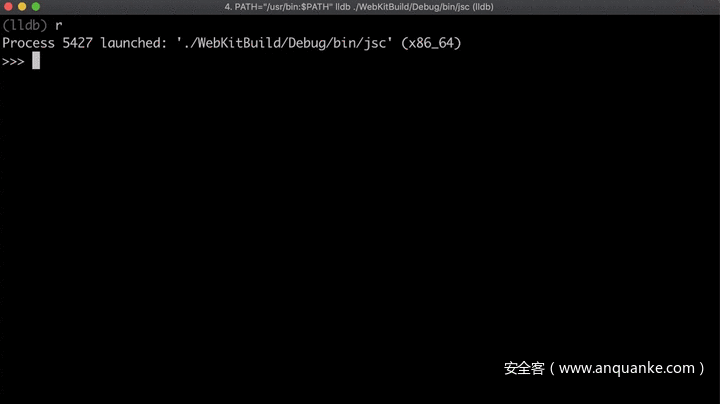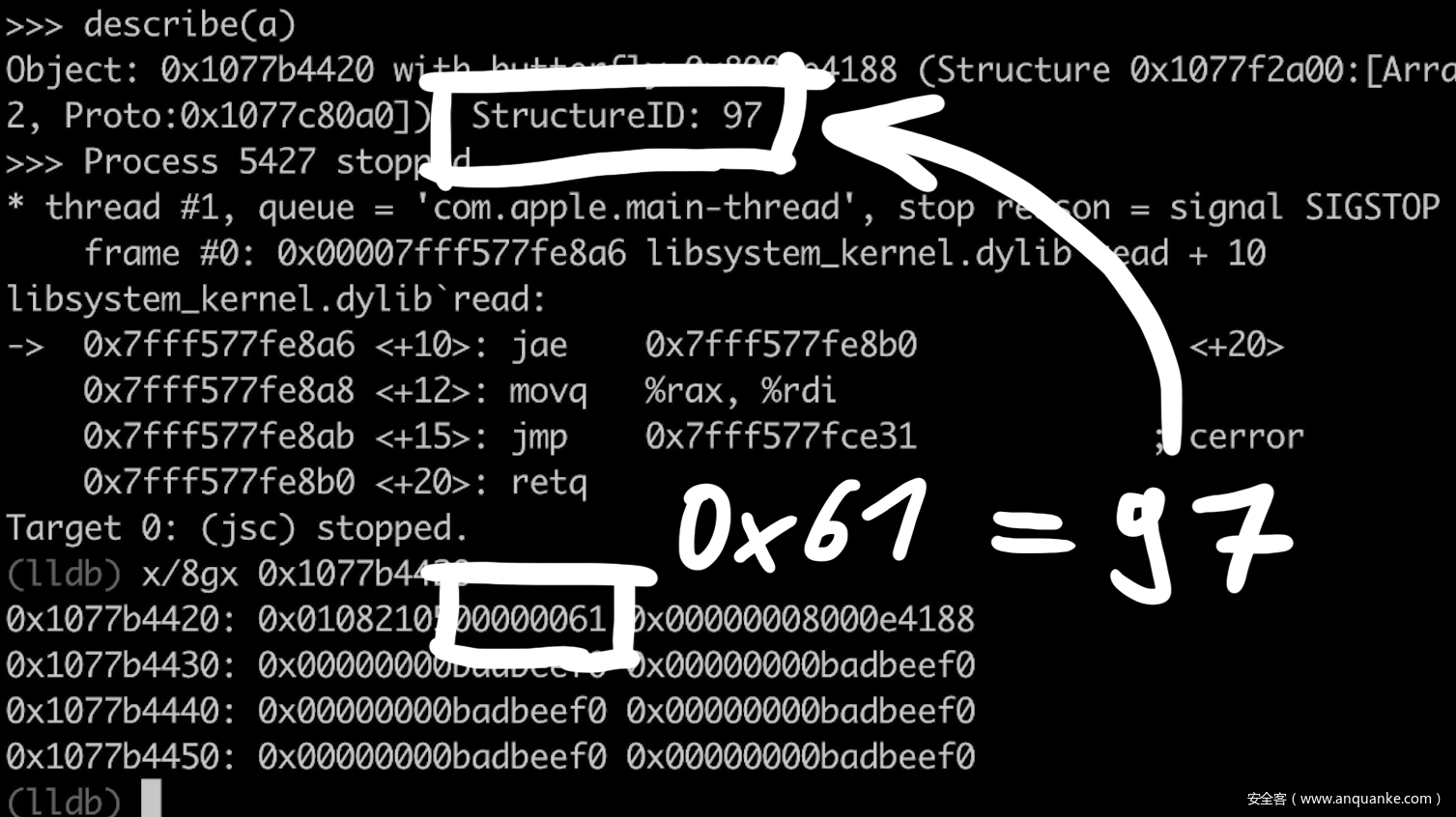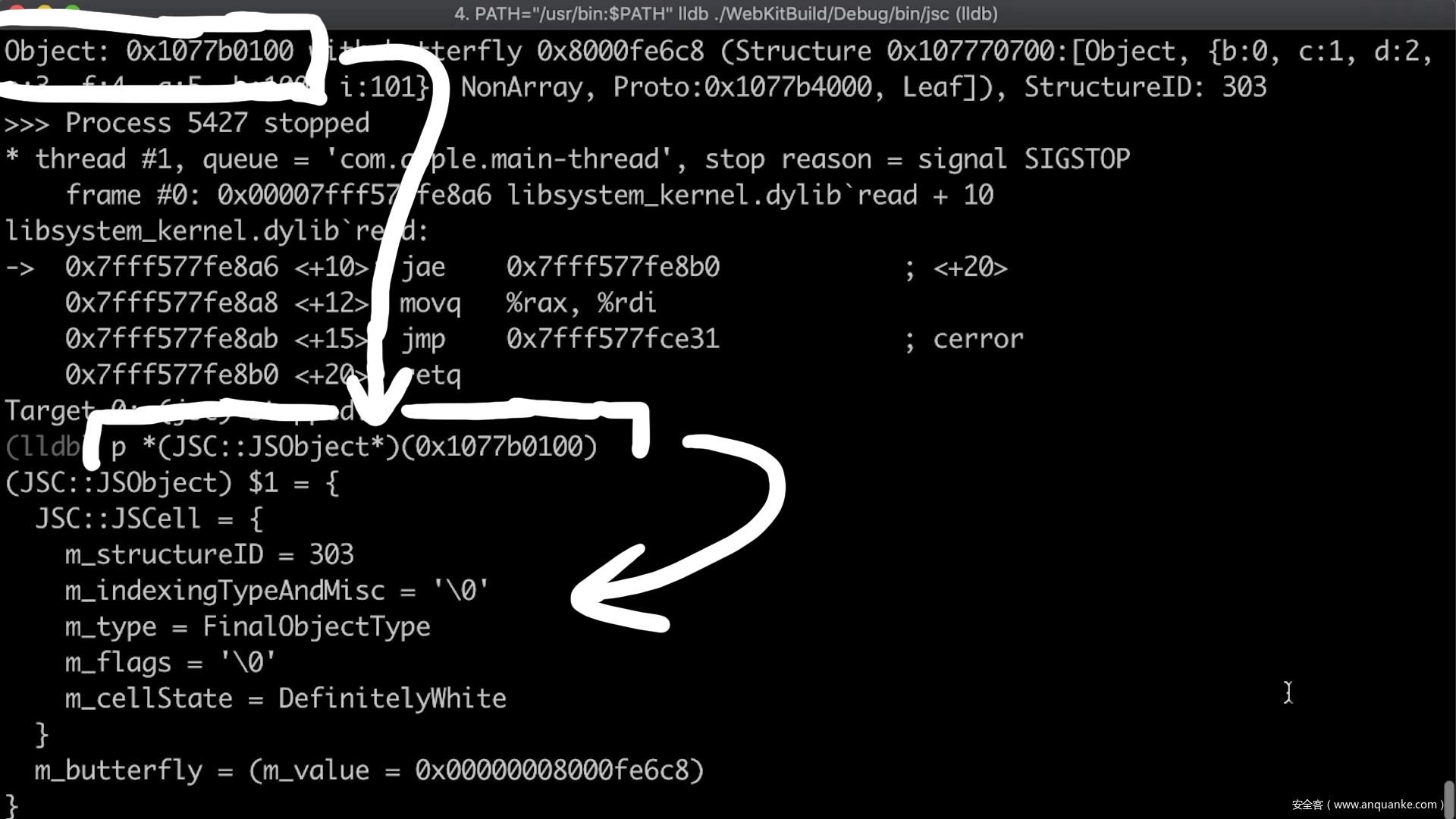0x00 前言
在本文中,我们来分析JavaScript在内存中的基本结构,同时了解一下其中涉及到的butterfly(蝶式)结构。
我们可以通过内存中的JSObject结构来了解JavaScriptCore内部实现。之前saelo已经在phrack的一篇文章中讨论过这方面内容,但我希望能利用上篇文章中介绍的调试器技术来分析这些知识点。在上篇文章中,我们快速过了一遍[1, 2, 3, 4]数组的内存结构,找到了这些数值,但我们还发现这些数值的高位全都被设置为0xffff,这里我们来了解一下为什么会出现这种情况。
0x01 JSValue源代码
JavaScript中有个非常重要的类,可以用来处理各种数值:JSValue类。我们可以在JSCJSValue.h源文件中看到类定义,根据类定义,该类应该可以处理各种类型值,如Integer、Double或者Boolean。
//[...]
bool isInt32() const;
bool isUInt32() const;
bool isDouble() const;
bool isTrue() const;
bool isFalse() const;
int32_t asInt32() const;
uint32_t asUInt32() const;
int64_t asAnyInt() const;
uint32_t asUInt32AsAnyInt() const;
int32_t asInt32AsAnyInt() const;
double asDouble() const;
bool asBoolean() const;
double asNumber() const;
//[...]
这个类中包含一个编译器开关,针对32位及64位架构可以使用不同的实现。但现在大部分都是64位架构,因此我们主要关注这方面实现。代码中还有一大段注释,解释了什么是JSValue。仔细阅读注释,后面我们将多次回顾其中内容。
//[...]
#elif USE(JSVALUE64)
/*
* On 64-bit platforms USE(JSVALUE64) should be defined, and we use a NaN-encoded
* form for immediates.
*
* The encoding makes use of unused NaN space in the IEEE754 representation. Any value
* with the top 13 bits set represents a QNaN (with the sign bit set). QNaN values
* can encode a 51-bit payload. Hardware produced and C-library payloads typically
* have a payload of zero. We assume that non-zero payloads are available to encode
* pointer and integer values. Since any 64-bit bit pattern where the top 15 bits are
* all set represents a NaN with a non-zero payload, we can use this space in the NaN
* ranges to encode other values (however there are also other ranges of NaN space that
* could have been selected).
*
* This range of NaN space is represented by 64-bit numbers begining with the 16-bit
* hex patterns 0xFFFE and 0xFFFF - we rely on the fact that no valid double-precision
* numbers will fall in these ranges.
*
* The top 16-bits denote the type of the encoded JSValue:
*
* Pointer { 0000:PPPP:PPPP:PPPP
* / 0001:****:****:****
* Double { ...
* FFFE:****:****:****
* Integer { FFFF:0000:IIII:IIII
* *
* The scheme we have implemented encodes double precision values by performing a
* 64-bit integer addition of the value 2^48 to the number. After this manipulation
* no encoded double-precision value will begin with the pattern 0x0000 or 0xFFFF.
* Values must be decoded by reversing this operation before subsequent floating point
* operations may be peformed.
*
* 32-bit signed integers are marked with the 16-bit tag 0xFFFF.
*
* The tag 0x0000 denotes a pointer, or another form of tagged immediate. Boolean,
* null and undefined values are represented by specific, invalid pointer values:
*
* False: 0x06
* True: 0x07
* Undefined: 0x0a
* Null: 0x02
*
* These values have the following properties:
* - Bit 1 (TagBitTypeOther) is set for all four values, allowing real pointers to be
* quickly distinguished from all immediate values, including these invalid pointers.
* - With bit 3 is masked out (TagBitUndefined) Undefined and Null share the
* same value, allowing null & undefined to be quickly detected.
*
* No valid JSValue will have the bit pattern 0x0, this is used to represent array
* holes, and as a C++ 'no value' result (e.g. JSValue() has an internal value of 0).
*/
仔细阅读注释后,大家可以注意到其中涉及到JSValue的编码表,其中解释了我们在数组中看到的0xffff。JSValue可以包含不同类型,通过高位来定义具体是什么类型。注释中也提到了为什么JavaScript即使在64位架构上也只处理32位整数,这是因为JSValue通过将顶部32位设置为0xffff0000来编码整数。如果顶部比特位为0x0000则代表指针,如果是其他比特位则都为float/double。
Pointer { 0000:PPPP:PPPP:PPPP
/ 0001:****:****:****
Double { ...
FFFE:****:****:****
Integer { FFFF:0000:IIII:IIII
此外其中还包含我们经常在JavaScript中看到的一些常量,这些常量可以编码成JSValue。比如False为0x06,Null为0x02。
False: 0x06
True: 0x07
Undefined: 0x0a
Null: 0x02
但我们还是在内存中观察一下。
0x02 使用调试器
首先我们可以创建包含各种不同类型的一个奇怪数组,然后在内存中观察该数组。很快我们就会发现奇怪的地方,第一个元素应该是一个整数,然而当在内存中观察时,我们发现其实它是一个float。为什么会出现这种情况?
[0x1337,13.37,false,undefined,ture,null,{},0x41424344]
让我们慢慢分析,逐个元素来构造数组。通过这种方法,我们可以观察到整个数组的内部类型在不断变化,并且第一个元素有时候也会被转换成float。
这表明JavaScriptCore在后台会有各种操作,我们来仔细分析一下。
0x03 在内存中识别JSValue
将内存中数组的值与关于JSValue的信息进行对比,我们可以很容易识别出各种常量,如undefined或者false。
上图中JSValue常量分别为false、undefined、true以及null。
我们创建的空JavaScript对象显示为一个指针,因此这是一个地址,实际的对象存储在其他地方。
图. JSValue:对象/指针
当然,这里我们还可以通过0xffff0000前缀来识别Integer。
图. JSValue:Integer
0x04 Butterfly
当观察describe()函数的输出时,我们可以看到所谓的“butterfly”(蝶式)地址。根据前面的内存分析结果,我们已经知道其中包含数组元素,但为什么会跟蝴蝶关联在一起呢?
当我们观察该地址所指向的具体位置时,原因就不言而喻。通常情况下地址/指针指向的是某个结构的起始处,但这里指向的是中间位置。指针的右侧为数组元素,指针的左侧为数组长度以及其他对象属性值。
0x05 Structure ID
除了蝶式地址,我们还可以在内存中看到作为对象一部分的其他值。前8个字节包含描述某些内部属性的一些标志以及非常重要的StructureID。这个值定义了该偏移地址的具体结构。
图. 内存中的StructureID
我们可以修改各种内容来分析相关对象,然后观察StructureID是否发生改变。比如,当我们往某个对象中添加了一些属性(如a.x = 1),可以看到StructureID会发生改变。实际上如果对象中没有包含该结构,那么就会创建新的StructureID,并且我们可以看到相应的值只是简单地递增。
0x06 总结
在这个视频中,我们可以找到关于内存中分析对象的其他文章,但我个人更建议大家使用调试器,自己操作一下试试。通过这个过程,我们应该能更深入理解基本的JavaScript对象和类型的内部结构,后续我们将以此为基础开展研究。
最后提一下,我们当然可以使用lldb的打印功能来使用调试版本的符号信息。如下图所示,我们可以看到属于JSCell头的StructureID及标志,并且可以看到蝶式地址是JSObject类的一部分。


















发表评论
您还未登录,请先登录。
登录